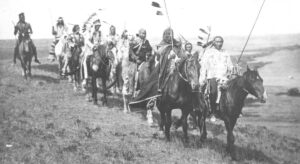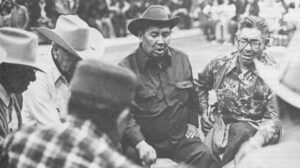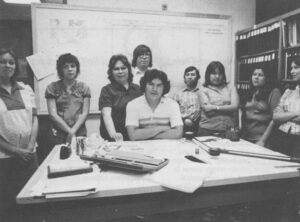LAME DEER, Mont.–As energy development accelerates in the West, trouble comes with it. Ranchers object when a state legislature decides to allocate thousands of acre-feet of water to a coal slurry pipeline. Homeowners protest when their wells go dry after a strip mine is dug. And when power companies try to condemn prime farm land for a transmission line, farmers holler.
Among the most affected groups are American Indians whose reservations sit on some of the largest and most coveted reserves of coal, uranium and oil shale in the West. Resolving conflicts over energy development between tribal administrations and individual tribal members is a special matter, however, because of profound differences between the American legal system and ancient Indian traditions.
The United States has a 200 year history of laws, legal precedents and administrative procedures that determine a frame work for settling such disputes. On the other hand, many tribal governments are still in limbo between their old ways-unwritten codes of behavior and decisions by consensus-and the new. They are still writing laws and just starting to adopt environmental regulations.

While the tribes need time to develop their governmental institutions, energy conflicts on Western reservations demand immediate action. Today, many tribal governments stand on the brink, still undecided on whether to exploit their vast resources of coal, uranium and oil shale. But as more tribes plunge into exploiting these resources, confrontations between tribal members and their governments are likely to become more frequent and they threaten to become more violent. As these conflicts occur on the reservations, they exert strong pressure on the tribes’ weakest and least developed function–their judiciary systems.
Centuries before the Europeans tried self-government, the Indians practiced it. “It took the white colonists about 170 years to rid themselves of the traditional pattern of the divine right of kings,” legal scholar Felix Cohen said.
Each tribe had its own form of government, with varying levels of sophistication. The Cheyenne, for example, had a system of jurisprudence tailored to the needs of a communal, nomadic society. While rules were not written down, they were known and accepted. Punishment was meted out to retain order, but the methods were chosen with an eye to minimizing disruptive resentments. It was clear who made decisions, how they were chosen and how the rest of the people were involved in decision making.
However, during the 1800s, after annihilation of Indians became too unpopular politically, the United States assigned tribes to reservations and systematically undermined tribal governments by imposing rule by the Congress, the courts and other more subtle methods.
From 1850 to 1970, the Indian people felt their voices had no importance and their leaders lacked real power. “Not until I was 15 years old was there any tribal government functioning,” said LaDonna Harris, a Comanche now in her forties who heads the organization, Americans for Indian Opportunity. “There was almost no government over my grandfather’s lifetime,” she said.
Medicine Men
The loss of faith started when medicine men couldn’t cure their people of the Europeans’ smallpox, she said. It grew as Congress divided up tribal lands among the members and non-Indian homesteaders and as the Bureau of Indian Affairs used tribal courts to impose its own standards of behavior. BIA-picked Indian judges punished tribesmen for practicing their customs and religion, such as the sun dance and the use of medicine men.
In 1934 Congress passed the Indian Reorganization Act, which allowed tribes-on paper at least-to reestablish and assert their governing powers. The act gave tribes the option of adopting written constitutions. Because they remembered little of their traditional systems, most tribes chose constitutions based on a BIA model; a few, such as the Pueblos in New Mexico, retained their old systems.
The act reduced the power of the Secretary of the Interior to interfere with internal tribal matters, saying, for example, that tribal consent was required before the federal government could sell or lease tribal land.
However, the federal government continued to try to assimilate Indians into the mainstream. Children were taken away to BIA boarding schools where they were taught English and the virtues of competition and individuality. The traditional values of unselfishness and cooperation, which the old order depended upon, were often not passed on.
The situation began to change when Congress passed the Indian Self-Determination Act in 1975, giving tribes the authority to contract for and fully administer federal funds. The shift has been gradual, partly because some tribes are not ready to assume the responsibilities and partly because some old-line BIA personnel guard their duties jealously.
Thus tribal governments adopted their present structures less than 50 years ago and many have actually been functioning less than 10 years. They lack a financial base since they cannot depend upon income or property taxes as other governments do. The money must be stretched to pay the tribal chairmen and council members, who often receive only expense reimbursement. And, the judicial systems go begging with little money from the federal or tribal governments for salaries, facilities or training.
So far the tribes have been lucky. With a few notorious exceptions, primarily on the Navajo Reservation, resource conflicts have not ended up in the courts.
However, a recent conflict on the Northern Cheyenne Reservation in Montana may be a harbinger of things to come. For years the tribal members consistently supported their council’s energy-related decisions, including seeking federal legislation to cancel coal leases on the reservation and filing a lawsuit to protect the clean air there.
Then in 1980 the tribal council committed the entire halfmillion acre reservation to oil exploration, including lands owned by individuals. Several Cheyenne objected to the contract with Atlantic Richfield Company (ARCO) and collected 400 signatures on a petition demanding a referendum.
The council ignored the petition. When the protestors took the matter to tribal court, Chief Judge Carol Redcherries ruled in their favor. The case was appealed, but the appellate judge was Calvin Wilson, the tribal attorney who had helped prepare the ARCO contract and he predictably ruled against the protestors. Only after the BIA insisted, did the council schedule the referendum wanted by the protestors. Voters approved the council’s contract with ARCO by a wide margin.
But the trouble was not over. The tribal chairman, Allen Rowland, fired Redcherries, saying the judge had no authority to overrule the council. And when a tribe member, Gilbert Redneck, refused to allow oil exploration crews on his land, the council ordered him to court.
This battle illustrates the quandary of many tribal governments. They have avoided exactly duplicating the U.S. form of government- three separate branches of government and strict written safeguards for individual liberties. Yet this is what their people are now being brought up to expect and demand. Many Indians don’t remember how the individual and his rights fit into the old ways, nor have they decided how to combine the old and the new.
Separation of powers is rare. A recent study of 21 tribes with energy resources found that 14 appoint judges who serve at the pleasure of elected leaders. Seven of the tribes have informal appellate courts or none at all, and three of the tribal councils, which are legislative bodies, serve as the appellate courts. Complaints of political interference with judges abound, according to the National American Indian Court Judges Association.
The Indian Judiciary
On the Navajo Reservation in the Southwest, where the courts were beginning to gain some autonomy, the tribal administration created a body known as the supreme judicial council. This council, which is separate from the regular court system, can be appealed to whenever a tribal court invalidates a Navajo legislative decision. Since the majority of its members are also on the tribal council, however, it has consistently decided in favor of the legislative council and against the court judges.
The National American Indian Court Judges Association says political interference of this sort is becoming less frequent across the country. In fact the National Tribal Chairmen’s Association went on record supporting the independence of Indian courts and acknowledging that the Indian judiciary has a status equal to other branches of tribal government.
But until recently, Indians have tended to see their judges as part of a political system, rather than as independent officers charged with applying and interpreting the law. The Northern Cheyenne situation exemplifies this: Allen Rowland defended firing Redcherries by saying, “We don’t have separation of powers here.”
Rowland sees the polling place as the forum for grievances. “The silent majority might not say a damn thing, but they’ll vote you out if they want a change,” he said. Indeed, his argument that the dissidents represent a small percentage of the Northern Cheyenne population seemed to be vindicated at the polls when the council’s ARCO deal was approved and when he was reelected by a landslide.
At the same time, the Cheyenne voters defeated a council member whom they perceived as being responsible for the more flagrant abuses of power in connection with the ARCO controversy. And when Gilbert Redneck came before the tribal judge who was appointed to replace Redcherries, Redneck was treated fairly although he lost his case. While Mark Elkshoulder, the replacement judge, was expected to rule unilaterally for the council, he granted Redneck an injunction, keeping the oil exploration crews off the land while Redneck appeals his case. In addition, Calvin Wilson disqualified himself as appellate judge, and an impartial lawyer from outside the reservation community was chosen to hear the appeal.
Closing the Gap
If Redneck loses his appeal, however, few options are open to him, according to his attorney, Greg Todd. The Indian Civil Rights Act of 1968 provides safeguards for all Indians. But the U.S. Supreme Court ruled in 1978 (Santa Clara v. Martinez) that lawsuits involving violations of the act are internal tribal matters. Most interpretations of this ruling say that civil rights suits brought by an individual against his tribal government must be settled in tribal-not federal-court.
If instead of filing a civil rights action Redneck challenged the legality of the ARCO contract as a whole, he could turn to federal court, as dissidents on the Navajo Reservation have done on more than one occasion. They have sued the federal government, saying the administration did not fulfill its responsibilities as “trustee” for the Indians or their resources. None of these suits have been successful, however.
Todd is not optimistic that administrative appeals would be successful for Redneck’s complaint. The Interior Department has recently started to back off from what it considers internal matters. The BIA told the Cheyenne dissidents they had to submit their referendum petition to the tribe-not the federal government. The agency went out of its way to approve the tribal council’s ARCO contract even though the department solicitor in Washington, D.C., said it did not meet federal requirements. And the BIA steered clear of involvement in any of the tribal judicial proceedings.
Anson Baker (a Mandan-Hidatsa) is BIA director for the Billings, Montana, area, which includes the Northern Cheyenne Reservation. He said he believes strongly in separation of powers, and he will say so to the Northern Cheyenne Tribal Council, if the members ask.
“I don’t want to do things the way the BIA did it 40 years ago,” he said. While he admits it is sometimes difficult to watch the tribes’ struggles, he said, “Sometimes you have to go back to find yourself-you have to learn to crawl before you can learn to walk.”
The Billings area BIA has hired a judicial consultant to work with the tribes at their request. But generally, the level of federal funding for training and staff has not kept up with the greater responsibilities the tribal courts are facing. Tribal judges have limited experience and no background in law, but they can bridge the gap between law and tribal culture better than outsiders.
The National American Indian Court Judges Association and other organizations are providing training, and the quality of the judges’ work is improving. The association has also prepared model standards to help tribes protect their judges from political vulnerability.
“If the Indian judiciary incorporates more concepts of Indian traditional justice and locally held values, rather than automatically replicating non-Indian systems, it should increase overall respect for the Indian judiciary,” according to the association.
Ethnocentrism
It is easy for outsiders to bring ethnocentric, missionary zeal to the question of tribal court reform. However, Indians are not likely to be impressed by arguments that non-Indian courts are a good model. Too often they have been subjected to judgments that they considered inequitable and inconsistent and that reflected political considerations rather than fair interpretations of law.
Al Ziontz, an attorney based in Seattle who has represented the Northern Cheyenne Tribe for years, said rigid structures to protect rights might be more relevant in mass societies where the state is a “great and impersonal force” than in tribal communities.
In some cases rights that are critical to the rest of society are clearly inappropriate. Pueblo Indians, whose government is based on their religion, would not want their courts to impose freedom of religion.
Tribal court reform is an issue to be solved by the tribes themselves. But internal pressures are now building to make the tribal leaders accountable to someone. Resource development decisions are irreversible once the wells are drilled or the surface mine site stripped. And choosing to oust a chairman in two years at the polls won’t keep the dragline from the door today.
Consequently some tribal members are turning to outside attorneys to help them challenge such decisions. Gerald Wilkenson (Cherokee) is executive director of the National Indian Youth Council, whose attorneys have represented individual Indians in several such situations. He said many tribal governments are glad when his organization steps in. “It offers a safety valve-some kind of mechanism for the people other than occupying the chairman’s office,” he said.
However, at other times tribal leaders see challenges of council decisions as attacks on the sovereignty of the tribe. Wilkenson objects to this attitude. Pointing out that his organization only represents tribal members, he said, “You can’t hide behind tribal sovereignty to exploit your members … If a government perpetrates injustices, that society won’t continue to exist.”
Bill Parker, one of the Northern Cheyenne dissidents, agrees. He said his tribal government has done more to weaken its sovereignty than he. Unless the tribe provides for legal redress within its own system, the pressure builds, and the people will be forced to turn to the BIA or Congress for help, he thinks.
Accountability
If enough such cries of outrage were heard, Congress could decide to force its own judicial reforms upon the tribes, to provide for more intervention of federal courts, or to take more drastic action, such as terminating tribes’ special relationship with the federal government. The BIA already threatened to withdraw federal recognition and federal funds from tribes that flagranty abuse individual rights. However, Indian advocates objected strenuously, and the policy was rescinded.
Wilkenson believes the tribes will eventually solve the problem of accountability. “The more experience they have in the elective process, the more skill they’ll develop in handling complaints,” he said.
They cannot afford to err. Sam Deloria, director of the American Indian Law Center, said, “City officials fear not getting reelected if they make a mistake. Tribal officials know that every throw of the dice is risking the future of Indian government.”

©1980 Marjane Ambler
Marjane Ambler concludes her fellowship study on Indian energy policies with this issue.






